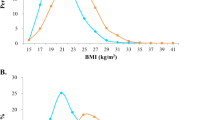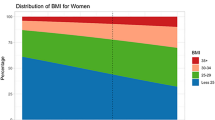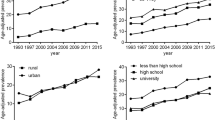Abstract
Objective:
To describe body mass index (BMI, in kg/m2) distribution patterns and trends among Chinese adults, aged 20–45 years (1989–2000).
Design:
A descriptive, population-based study of BMI change.
Setting:
Chinese provinces (eight in 1989 and 1997; nine in 2000), representative of the household-based surveys (the China Health and Nutrition Survey, 1989–2000) using multistage, random cluster sampling, supplemented with annual household consumption survey data of the State Statistical Bureau (SSB).
Subjects:
A total of 4527, 4507 and 4046 adults, aged 20–45 years, in 1989, 1997 and 2000, respectively.
Measurements:
BMI (underweight: BMI<18.5 kg/m2 and overweight: BMI⩾25 kg/m2). Percentile curves for BMI in 1989 and 2000 were constructed by gender and age using the LMS (lambda, mu, sigma) method.
Results:
Compared with 1989, the 2000 BMI distribution curves flattened at higher levels of BMI (men and women). There was a 13.7% increase in the proportion of men and a 7.9% increase of women who were overweight or obese with a resulting greater change in the annualized prevalence rate for men. This increase in the prevalence of overweight and obesity was far greater than the decrease (2.1% for men; 2.2% for women) in that of underweight. Age–gender-specific percentile curves showed BMI increases mainly among women, aged 35–45 years, and among men at all age groups.
Conclusions:
Chinese BMI dynamics show much greater rates of change among men, aged 20–45 years, than among women, with the increase among women concentrated between ages 35 and 45 years. These changes portend large shifts in other diet-related non-communicable diseases in China over the following decades. Controlling the increasing trends of BMI, especially in men, is an important public health problem facing China.
This is a preview of subscription content, access via your institution
Access options
Subscribe to this journal
Receive 12 print issues and online access
$259.00 per year
only $21.58 per issue
Buy this article
- Purchase on Springer Link
- Instant access to full article PDF
Prices may be subject to local taxes which are calculated during checkout





Similar content being viewed by others
References
State Statistical Bureau. China Statistical Yearbook 2002. China Statistics Press: Beijing, 2003.
Du S, Lu B, Zhai F, Popkin BM . A new stage of the nutrition transition in China. Public Health Nutr 2002; 5 (1A): 169–174.
World Bank. World Development Indicators 2001. World Bank: Washington, DC, 2001.
State Statistical Bureau. China Statistical Yearbook 2000. China Statistic Press: Beijing, 2001.
Popkin BM, Horton S, Kim S, Mahal A, Shuigao J . Trends in diet, nutritional status, and diet-related noncommunicable diseases in China and India: the economic costs of the nutrition transition. Nutr Rev 2001; 59: 379–390.
Bell AC, Ge K, Popkin BM . Weight gain and its predictors in Chinese adults. Int J Obes Relat Metab Disord 2001; 25: 1079–1086.
Bell A, Adair LS, Popkin BM . Ethnic differences in the association between body mass index and hypertension. Am J Epidemiol 2002; 155: 346–353.
Popkin BM . Dynamics of the nutrition transition and its implications for the developing world. Forum Nutr 2003; 56: 262–264.
Popkin BM, Gordon-Larsen P . The nutrition transition: worldwide obesity dynamics and their determinants. Int J Obes Relat Metab Disord 2004; 28 (Suppl 3): S2–S9.
Popkin BM, Kim S, Rusev ER, Du S, Zizza C . Measuring the full economic costs of diet, physical activity, and obesity-related chronic diseases. Obes Rev 2006 (in press).
Ge K, Weisell R, Guo X, Cheng L, Ma H, Zhai F et al. The body mass index of Chinese adults in the 1980s. Eur J Clin Nutr 1994; 48 (Suppl 3): S148–S154.
Beghin I, Cap M, Dujardin B . Guide to Nutritional Assessment (A). WHO: Geneva, 1988.
WHO. Physical Status: The Use and Interpretation of Anthropometry Report of a WHO Expert Committee Technical Report Series, No 854. WHO: Geneva, 1995.
Popkin BM, Paeratakul S, Zhai F, Ge K . Dietary and environmental correlates of obesity in a population study in China. Obes Res 1995; 3 (Suppl 2): 135s–143s.
Bell AC, Ge K, Popkin BM . The road to obesity or the path to prevention: motorized transportation and obesity in China. Obes Res 2002; 10: 277–283.
James PT . Obesity: the worldwide epidemic. Clin Dermatol 2004; 22: 276–280.
Cole TJ, Bellizzi MC, Flegal KM, Dietz WH . Establishing a standard definition for child overweight and obesity worldwide: international survey. BMJ 2000; 320: 1240–1243.
Cole TJ, Green PJ . Smoothing reference centile curves: the LMS method and penalized likelihood. Stat Med 1992; 11: 1305–1319.
Cole TJ . Using the LMS method to measure skewness in the NCHS and Dutch National height standards. Ann Hum Biol 1989; 16: 407–419.
Haslam DW, James WP . Obesity. Lancet 2005; 366: 1197–1209.
James Jr WPT, Ni Mhurchu C . Overweight and obesity (high body mass index). In: Ezzati MLA, Rodgers A, Murrary CJL (eds). Comparative Quantification of Health Risks: Global and Regional Burden of Disease Attributable to Selected Major Risk Factors. WHO: Geneva, 2004, pp 479–596.
Popkin BM, Conde W, Hou N, Monteiro CA . Is there a lag globally in overweight trends for children as compared to adults? Obesity (in press).
Paeratakul S, Popkin BM, Ge K, Adair LS, Stevens J . Changes in diet and physical activity affect the body mass index of Chinese adults. Int J Obes 1998; 22: 424–431.
Entwisle B, Susan ES, Zhai FY, Ma LM . Household economies in transitional times. In: Entwisle BaGEH (ed). Redrawing Boundaries: Work, Household, and Gender in China. University of California Press: Berkeley, CA, 2000, pp 261–283.
Entwisle B, Short SE, Bouma J, Zhai FY . Gender and family businesses in rural China. Am Sociol Rev 1995; 60: 36–57.
Du S, Mroz TA, Zhai F, Popkin BM . Rapid income growth adversely affects diet quality in China – particularly for the poor!. Soc Sci Med 2004; 59: 1505–1515.
Popkin BM . Urbanization, lifestyle changes and the nutrition transition. World Dev 1999; 27: 1905–1916.
Blumenthal D, Hsiao W . Privatization and its discontents – the evolving Chinese health care system. N Eng J Med 2005; 353: 1165–1170.
Acknowledgements
We thank Carlos Monteiro and Wolney Conde who suggested us to use the LMS approach to studying percentile changes in the BMI distribution and then provided us with computer code to allow us to program these changes. We thank the NIH (R01-HD30880, R01-HD38700, Fogarty International Center training grant) for financial support for the analysis. We also wish to thank Ms Frances L Dancy for administrative assistance, Mr Tom Swasey for graphics support and Mr Bill Shapbell for editorial assistance.
Author information
Authors and Affiliations
Corresponding author
Rights and permissions
About this article
Cite this article
Wang, H., Du, S., Zhai, F. et al. Trends in the distribution of body mass index among Chinese adults, aged 20–45 years (1989–2000). Int J Obes 31, 272–278 (2007). https://doi.org/10.1038/sj.ijo.0803416
Received:
Revised:
Accepted:
Published:
Issue Date:
DOI: https://doi.org/10.1038/sj.ijo.0803416
Keywords
This article is cited by
-
Effect of socioeconomic characteristics and lifestyle on BMI distribution in the Chinese population: a population-based cross-sectional study
BMC Public Health (2021)
-
Assessing the relationship between pregravid body mass index and risk of adverse maternal pregnancy and neonatal outcomes: prospective data in Southwest China
Scientific Reports (2021)
-
Prevalence and income-related equity in hypertension in rural China from 1991 to 2011: differences between self-reported and tested measures
BMC Health Services Research (2019)
-
Urban-rural-specific trend in prevalence of general and central obesity, and association with hypertension in Chinese adults, aged 18–65 years
BMC Public Health (2019)
-
The prevalence and increasing trends of overweight, general obesity, and abdominal obesity among Chinese adults: a repeated cross-sectional study
BMC Public Health (2019)



